Menu
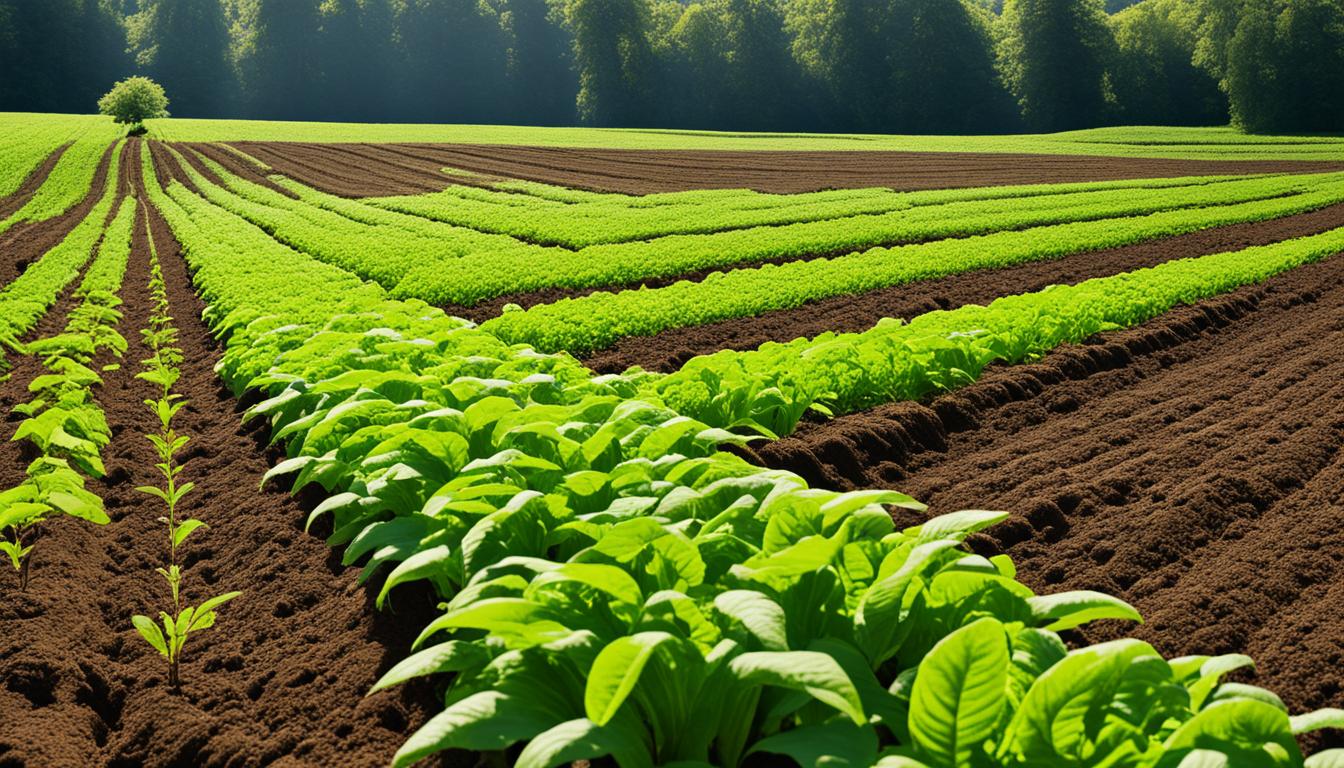
Did you know that organically managed soils contain 8.33 percent organic matter? This is more than the 7.37 percent in soils managed conventionally. The big difference shows how organic farming greatly helps soil health. It’s key for producing food that’s tough against challenges and safe for nature.
Healthy soil is vital for holding water, supporting diverse life, and using nutrients well. It also stores carbon, a huge help in fighting climate change. In the United States, there’s a big problem with soil losing quality. But, organic farming repairs this by adding carbon and protecting different species. Yet, we need to learn more about the best organic methods to keep soil healthy.
Studies keep finding new ways in which organic farming boosts soil quality. For example, soils rich in organic matter have more nutrients and are more stable. Also, it’s been found that tiny soil organisms play a major part in how soil works. This shows why using organic methods is important for keeping soil strong for the long haul.
Sustainable farming is vital for our food’s future. Managing soil organically is key. It boosts soil resilience and keeps nutrients like carbon cycling. In the United States, soils are at risk from bad farming. That’s why organic farming is crucial to keep soil health in check.
Research shows organic soils are better than others. They’re full of life and can hold more water. Plus, they’re better at storing carbon. This makes them great for keeping water, diverse organisms, and vital nutrients in check.
Worldwide, farming has lost a huge amount of soil carbon. But organic farming can store more carbon in the ground. Since most of the world’s carbon is in soil, managing it organically is critical.
Soil health is its ability to sustain life – from plants to us. A big study looked at 153 articles on organic farming. They found good soil health has physical, chemical, and biological signs:organic soil management.
| Indicators | Metrics |
|---|---|
| Physical | Aggregate stability, water-holding capacity, infiltration, runoff susceptibility |
| Chemical | Nitrogen, phosphorus, potassium levels |
| Biological | Organic matter content, microbial biomass, earthworm abundance, weed pressure and diversity |
Cover crops really help soil health in organic farming. Roll-killed ones can beat weeds better than turning the soil. Adding compost and manure helps too. It makes soil hold more carbon and stay healthy. Using a mix of these methods boosts soil health the most.
In organic agriculture, the study of soil biology is key. It helps in growing strong ecosystems and healthy plants. Knowing about soil microorganisms is important. They boost soil health and fertility.
Organic farms have more soil microorganisms than traditional farms. This improves soil stability and the ability to hold water. Studies show that a variety of soil life plays a big part in keeping farms sustainable. Earthworms are essential too. They help by making the soil better for plants. This includes adding air, breaking down plant remains, and moving nutrients around. Having lots of microorganisms and earthworms means the soil is doing well.
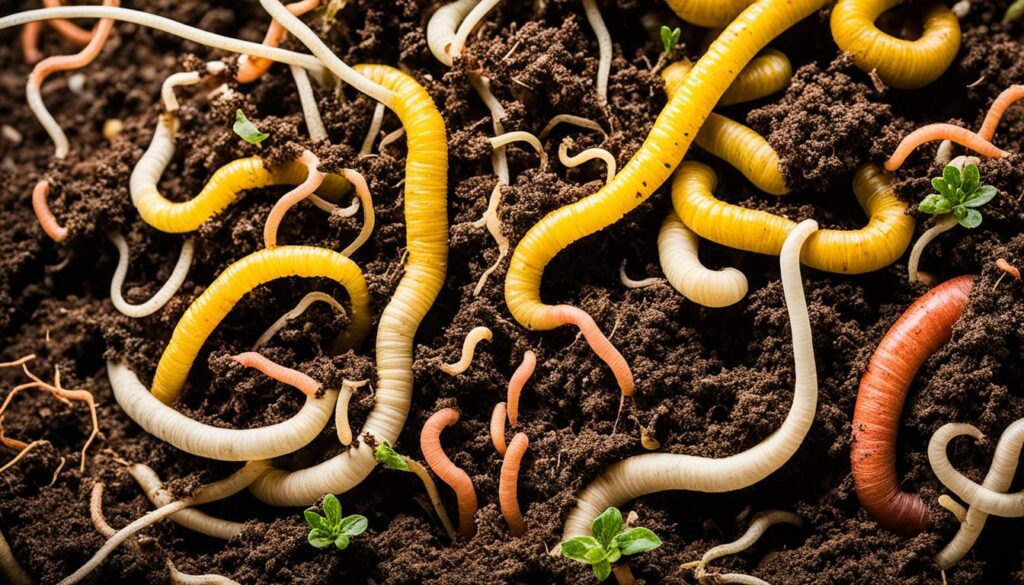
Beneficial microbes are vital in organic farming. They are key for good crop growth. Chen et al. (2020) found that organic farming helps build a rich network of soil life. This is great for recycling nutrients and keeping the ecosystem stable. The rich soil life also shows that there’s a healthy process of using and making soil rich. All this is crucial for nutrient supply and keeping the soil healthy.
Using natural farming methods helps boost soil health and sustainability. No-till farming, green manures, cover crops, and mulches are key. They help the soil hold water better, use nutrients more efficiently, and improve its structure.
No-till farming is great for keeping soil in good shape. It means not ploughing, which cuts down on soil washing away and keeps the soil moist. No-till farming also helps fight soil erosion and makes a better home for wildlife and helpful bugs.
To make no-till farming work, the soil must be left alone. Protecting the layer of organic carbon in the soil keeps its structure strong. This keeps the soil healthy overall.
Green manures and cover crops do wonders for soil health. Legumes, like clover, help the soil by adding nitrogen. This special job benefits from the help of tiny bacteria called rhizobia.
Having cover crops also cuts down on weeds, prevents nutrients from washing away, and stops soil from eroding. Studies show that using cover crops is very effective. They keep away weeds and feed the soil better than some other methods.
Mulching is key for keeping soil moisture just right. It stops water from evaporating so fast and helps the soil stay damp enough for health. Different kinds of mulch together do a lot for the soil more than just using one kind. They keep things like soil structure, nutrients, and microorganisms in balance.
When we talk about organic farming sustainability, we must look at how conservation agriculture plays a key part. Old techniques like terracing have kept crops growing for centuries in southern Europe and Asia. They show the value of past ways in today’s farming. This includes keeping the soil healthy and stopping it from eroding.
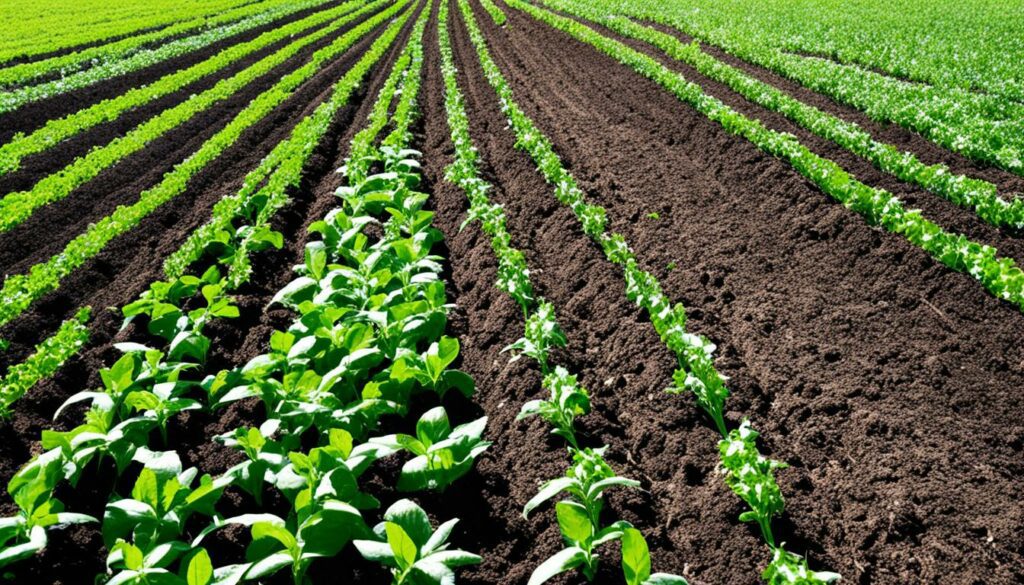
Keeping soil undisturbed is vital. No-till systems help a lot by cutting down on compaction and emissions, which keeps the soil carbon-rich. But, these methods need to be left alone to work well.
Windbreaks, made of rows of trees or shrubs, lower wind speed to save soil. They can shield soil far beyond their own height. These living fences are key in looking after the environment and making better growing climates.
Cover crops like triticale, rye, and barley slow down rain, lowering erosion. They also add to plant varieties and give homes to wildlife, like songbirds. Plants that help fix nitrogen in the soil, such as legumes, are also part of this, boosting soil health in a natural way.
Using different cover crops makes a farm more varied and does many natural jobs. In California’s almond farms, mixes of flowers are being tried. These mixes help helpful bugs and make pollination better, showing how farming can work well with nature.
In short, organic farming sustainability and ecological soil management go hand in hand. In keeping with these principles, methods like no-till farming, windbreaks, and growing cover crops are essential. They help save soil and invite more life into our farms.
Organic soil amendments make soil better by keeping more water, being harder to squash, and feeding plants well. They include things like composting, using manure, and adding biochar. These methods can boost the soil’s ability to grow plants and farm better.
Composting turns stuff like leaves and food waste into food for plants. It’s good for the soil because it makes it richer. The soil should have about 5% to 10% compost in places where we grow veggies and flowers. Compost is kind of heavy; one cubic foot weighs 40 lbs, and a cubic yard weighs around 1,100 lbs. But, this can change if it’s wet. Composts made from plants have certain nutrients, like a bit of nitrogen. This helps plants grow. It’s important to check composts’ quality to make sure they’re safe for plants, with no harmful chemicals.
Manure is also great for the soil. It comes from animals like cows and is used a lot on farms. Beef and dairy farms usually have more manure than others. It’s best to fully compost manure to get rid of bad germs and seeds. Manure gives the soil important nutrients and makes it good for small living things and the roots of plants. This makes plants grow better.
Biochar is special because it’s very rich in carbon. It helps the soil in different ways. It makes the soil structure better, keeps water in, and gives a home to helpful tiny life, improving the soil for a long time. Adding biochar is also good for the environment. It helps take bad stuff out of the air, making the Earth healthier.
Boosting soil fertility in organic ways is key to a rich soil that helps crops grow well. To keep these systems going, adding organic materials and methods is a must. They help make the soil more alive underground and add carbon. This makes the soil better for growing organic crops.
Soils managed organically have more types of tiny life in them. This life is very important for handling nutrients. It ensures that crops get what they really need to grow best. Besides common nutrients like nitrogen, phosphorus, and potassium, iron, zinc, and manganese are also vital for crops.
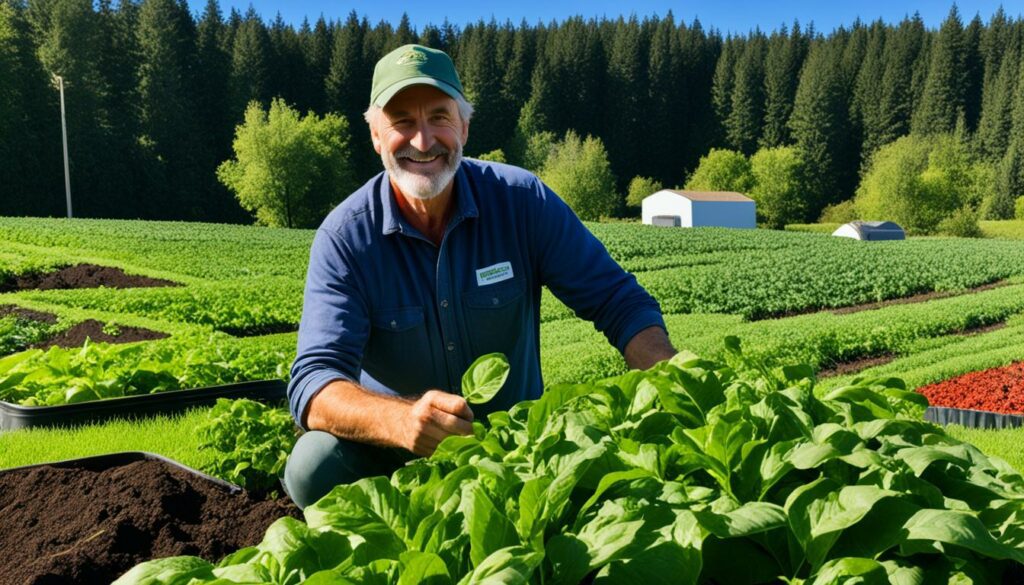
It’s important to know what’s in organic fertilizers and how much to use. These fertilizers usually have less nutrients than regular ones. So, you need to use more. Let’s look at how various organic fertilizers compare in nutrients and benefits:
| Organic Fertilizer | Main Nutrients | Additional Benefits |
|---|---|---|
| Alfalfa Meal | 3% Nitrogen | Enhances root growth |
| Bone Meal | High in Phosphorus | Improves flowering and root development |
| Feather Meal | 15% Nitrogen | Slow release nutrient |
| Fish Emulsion | Varies | Suitable for foliar feeding |
| Wood Ash | Contains P and K | Acts as a liming agent |
Nitrogen’s role from organic sources is vital for soil fertility in organic setups. Research shows that plenty of nitrogen from cover crops stays in the soil. This keeps nutrient use smart and safe for the environment. Thus, organic soil becomes perfect for great organic crops.
The soil’s pH level is a big deal for nutrient use and life in the soil. The right pH helps good microorganisms find their space to work. This is key for making nutrients available and for the soil’s overall health.
Choosing organic farming for the long haul shows big improvements. It makes soil richer and healthier for life over time than using traditional methods. This means more than just good soil. It’s about doing farming in a way that’s better for everyone.
Cover crops are vital for keeping soil healthy on organic farms. They help with nitrogen and stop soil from washing away. Choosing the right cover crops can really boost the soil’s quality.
Cover crops, especially legumes, are great for the soil. They grab nitrogen from the air, enriching the ground. This process acts like a natural fertiliser, perfect for organic farms without chemical help.
Nitrogen is key for organic farming. A big chunk of USDA project money has gone into studying cover crops. This is because they help with essential tasks like nitrogen fixing, which improves the soil.
Choosing the right cover crop types is important. Each kind does something special for the soil. Mixes of different cover crops are becoming more popular. They offer even more benefits for soil health.
Cover crops help manage soil nutrients and stop the ground from getting too compact. They also aid in cutting down on erosion. Plus, they attract helpful earthworms, promoting a vibrant soil ecosystem.
Ending cover crop growth at the right time is crucial. This prevents weed issues and too much nitrogen in the soil. Careful planning ensures you get the best from your cover crops.
| Benefit | Impact |
|---|---|
| Scavenges nutrients | Reduces nutrient runoff |
| Enhances soil structure | Mitigates soil compaction |
| Improves moisture retention | Ensures better water availability |
| Prevents erosion | Preserves topsoil |
Cover crops really make a big difference in organic farming. They help in many ways, like fixing nitrogen and making the soil better. This is why they are key for farmers who want to work in harmony with nature.
In the push for sustainable farming, using a mix of crops stands out. Farming different kinds of crops together helps the soil in many ways. It makes nutrients move better and lowers the chance of plant diseases spreading in the ground.
Switching crops around has lots of good effects. It makes the soil stronger and helps crops grow better. Farming this way increases the amount of crops you get by up to 38% over just growing one type. Plus, it cuts down harmful gas released into the air by 39%, which is good for our planet.
Healthy soil is key for farming that lasts a long time. Research from places like Washington, Iowa, and Florida shows adding things like cover crops and compost works well. For example, adding beans to the mix boosted the good bits in the soil by 8%.
In areas where they farm without ploughing and use lots of crops to cover the ground, the soil is also looked after very well. This keeps the ground strong and able to grow food without hurting the environment. This shows adding different crops and keeping the ground covered helps a lot.
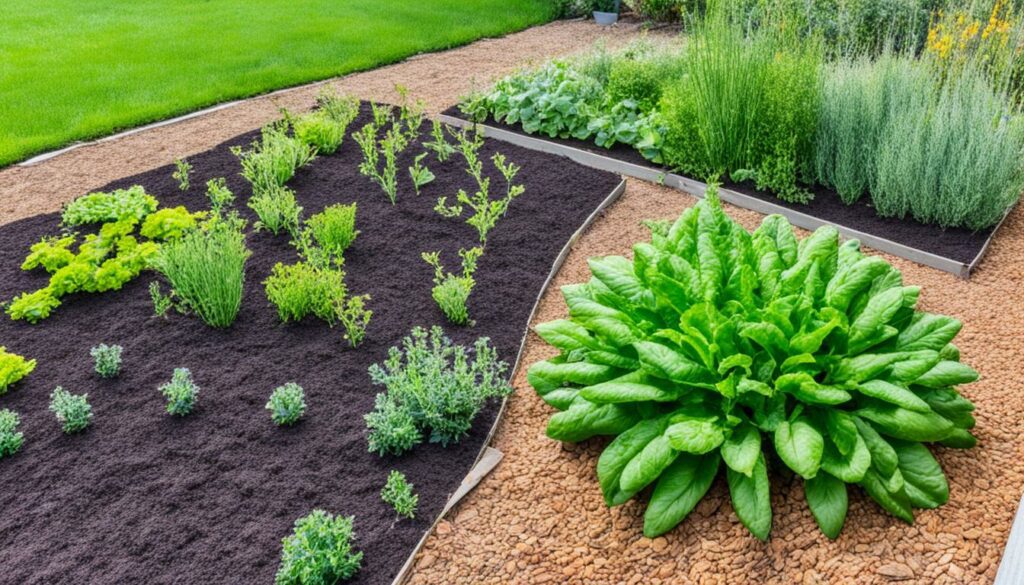
| Rotation Practice | Impact on Soil Health | Yield Improvement |
|---|---|---|
| Diverse Crop Rotations | Enhances soil structure and nutrient cycling | Up to 38% increase |
| Legume Inclusion | Increases soil organic carbon stocks by 8% | Supports sustainable production |
| Cover Crops | Reduces N2O emissions by 39% | Improves nitrogen fixation |
Improving soil health is key to fighting climate change. Regenerative soil practices help by storing carbon and promoting diverse life forms. This supports efforts to slow down climate change.
By using organic farming, we store more carbon in the soil. This reduces the harmful CO2 in the air. Also, the soil becomes healthier. Keeping permanent pastures adds organic matter. It helps friendly microorganisms thrive.
Permanent pastures are crucial for healthy soil. They are homes to many tiny creatures. With various plants, the soil becomes more alive and strong. This is vital for farming that lasts a long time.
Australia is facing soil troubles. Much of its farmland is no longer as fertile due to bad practices. Luckily, regenerative farming can turn things around. It’s very important, especially in dry areas. There, growing wheat affects the land greatly. By adopting better farming ways, the environment and farming can thrive together.
| Issue | Impact | Solution |
|---|---|---|
| Declining Soil Fertility | Reduces crop yield and soil health | Implement regenerative practices like composing and cover cropping |
| Mechanical Soil Disturbance | Damages biological soil structures | Limit tillage and use no-till farming methods |
| Pesticide Resistance | Leads to reduced effectiveness of chemical inputs | Adopt integrated pest management approaches |
| Consumer Concerns | Negative public perception and health risks | Prioritise minimal synthetic input use |
| Soil Erosion | Destroys topsoil faster than it can be formed | Adopt practices like mulching and maintaining permanent pastures |
We need to break through challenges to use these practices worldwide. Differences in what we know and money concerns are big. But, if we think long-term, we can make a huge difference. By using these methods, the land gets healthier. It also promotes a richer mix of life, making farming better for the future.
The impact of organic practices on soil stability is widely recognised today. It’s a key focus for both farmers and researchers. Organic farming methods are critical for improving soil structure. This helps control soil erosion and makes the soil more resilient against bad weather.
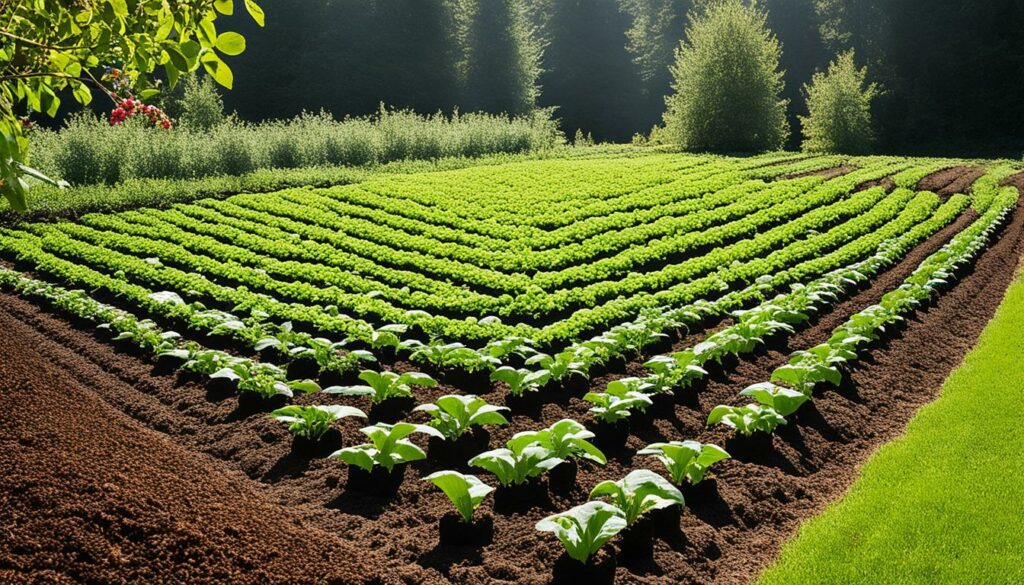
Research by Cardoso et al. (2013) shows that certain organic methods help with soil health. Techniques like mulching and using less tillage keep the soil in good shape. They make sure the soil stays undisturbed and is less likely to erode.
Preventing soil erosion is vital for producing food in a sustainable way. Organic practices strengthen the soil’s structure. A study by Eivazi & Tabatabai (1990) found that they make important soil enzymes work better. This helps to bind soil particles together more tightly. Also, work by Chen et al. (2020) points out that these techniques boost the health and function of soil microbes. This is key for the soil’s long-term resilience. Using organic materials to cover the soil cuts down erosion significantly. This helps keep the land fertile.
Using organic methods is key to keeping soil structure strong. Techniques like mulching, planting cover crops, and minimal tillage make the soil healthier. A study by Hobbs, Sayre & Gupta (2008) showed these practices are important. They help maintain the soil’s structure and keep its organic content high. This helps stop soil erosion.
The table below shows how organic and conventional farming compare when it comes to soil stability:
| Practice | Organic Farming | Conventional Farming |
|---|---|---|
| Soil Erosion Control | High | Moderate |
| Maintaining Soil Structure | Enhanced | Less Effective |
| Soil Microbial Diversity | Rich | Limited |
From the evidence, it’s clear that organic practices really help soil stability. They improve the soil’s ability to resist damage and control erosion. This shows why using organic methods in agriculture is so important.
Soil health indicators help us check soil quality in organic farms. They let us watch and care for the soil. For example, we look at aggregate stability. It shows how strong soil is against breaking apart with water. This helps us understand soil structure and prevent erosion.
Biological measures are also key. Microbial biomass, or the tiny life in the soil, shows how active and healthy the soil is. Checking these numbers regularly helps keep the soil in great shape.
Today, we have high-tech ways to check soil health accurately. These tests look at many different aspects of soil health. They help farmers improve their soil naturally. They are not just about the current state of the soil. They guide us in taking care of the soil for the future.
Using things like compost and manure is great for the soil. They add nutrients and help the soil hold onto carbon. This is good for fighting climate change because it keeps carbon out of the air.
It’s important to mix up organic additives. Research shows using a variety is better than just one. By looking at what these things have in them, we can make the soil better over time.
Farmers and scientists use soil health indicators to keep an eye on the soil. By staying diligent with these tools, we help the earth by growing food in a way that lasts.
Organic farming focuses on ways to keep and absorb water in the soil. By using organic methods, the soil can hold more water and let it in slowly. This means farmers can better deal with dry weather and reduce the risk of floods. It’s key for farming sustainably around the world.
Boosting the amount of organic matter in soil is central in organic soil management. Things like adding compost, changing the types of crops you grow, and using ‘cover crops’ all help. They make the soil better at holding water. Research finds that these changes can make corn fields 30% more productive in dry times. The soil also needs less water from farming.
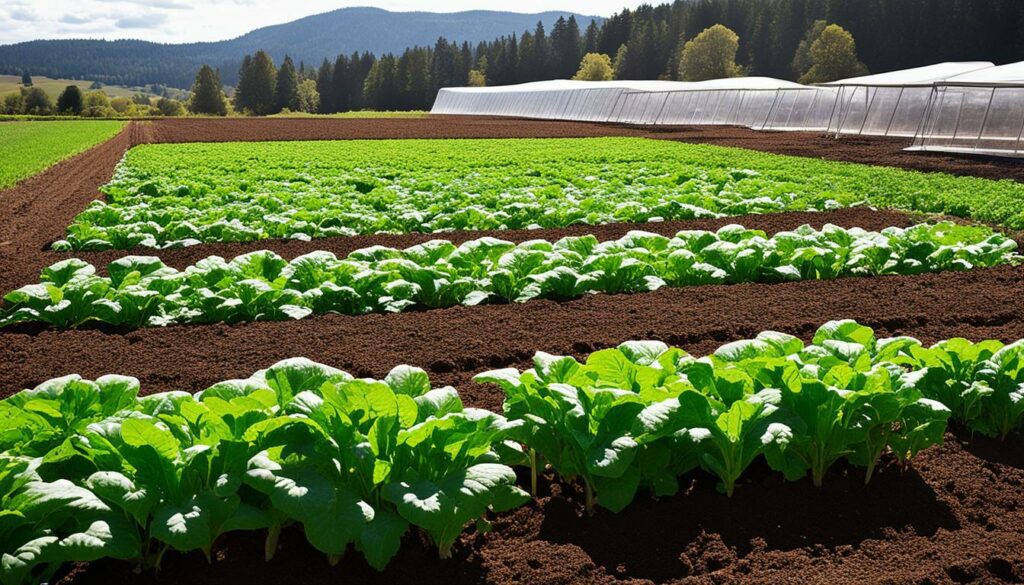
| Method | Impact on Water Retention | Impact on Soil Infiltration |
|---|---|---|
| Compost Application | Increases organic matter | Enhances soil structure |
| Cover Crops | Improves moisture retention | Enhances water infiltration |
| No-Till Farming | Reduces soil disturbance | Maintains soil porosity |
Organic farmers use methods to stop soil washing away in the rain. This helps the ground stay stable and keeps its rich parts. Covering soil with mulch and not turning it over too much are big helps. It means less water runs off the fields. This is good for water that goes underground or into rivers. It helps all farmers look after the land whether they use organic ways or not.
By using water retention and organic soil management methods, farmers can cope with bad weather better. Plus, the land becomes healthier and more productive over time. Combining these steps supports the earth where food grows. It’s a win for farming, the environment, and the people who depend on it.
Looking at organic farming case studies shows clear benefits from different soil health methods. For example, at Okuye Farms, Ralf Sauter saw an increase of $657 per acre. This led to an overall rise of $76,155 across 116 acres in California. By focusing on soil health, they improved their income a lot.
Tom and Dan Rogers managed to up their earnings by $991 per acre. This meant a rise of $173,345 over their 175 acres. They did this with steps like managing nutrients, using cover to protect the soil, and adding compost.
Research into soil health shows benefits are different on each farm. For instance, Christine Gemperle in California increased her profit by $499 per acre with cover crops. This meant an extra $9,976 for her 20-acre almond farm.
In New York, Jay Swede boosted his profit by $55 per acre. This added up to $82,257 on his 1,500 acres, thanks to his special soil techniques.
Over in Illinois, John and Jim Macauley made an extra $44 per acre. This brought in $25,036 over 1,106 acres, using methods like no-till and cover crops. And at HaR-Go Dairy Farm, Steve Gould increased his earning by $11 per acre. On his 450 acres, that meant a yearly uptick of $4,780 and an 18% return.
| Farmer | Location | Improvement Per Acre | Total Improvement | Practice |
|---|---|---|---|---|
| Ralf Sauter | California | $657 | $76,155 | Soil Health Practices |
| Tom and Dan Rogers | California | $991 | $173,345 | Nutrient Management, Conservation Cover, Mulching, Compost |
| Christine Gemperle | California | $499 | $9,976 | Cover Crops |
| Jay Swede | New York | $55 | $82,257 | Soil Health Practices |
| John and Jim Macauley | Illinois | $44 | $25,036 | No-Till, Cover Crops, Nutrient Management |
| Steve Gould | Illinois | $11 | $4,780 | No-Till, Cover Crops, Nutrient Management |
Studying these cases, we see different outcomes. For example, Eric Niemeyer at MadMax Farms raised his income by $38 per acre, adding $47,569 over his 1,250 acres. Dan Lane at Homewood Farms in Ohio increased his profit by $56 per acre. This meant $102,366 more over his 1,830 acres.
In Virginia, Bob Waring improved his earnings by $55 per acre, earning $16,439 on his 300 acres. This was all thanks to using cover crops and managing nutrients well. Research funded by the USDA shows the valuable lessons we can learn from these organic farming experiences.
Wrapping up our look into organic farming, it’s clear that taking care of the soil is key. The FAO warns us that more than 1.5 billion hectares of global land are suffering. This shows we urgently need to improve our soil health tactics.
The methods of organic farming, like making compost and using cover crops, can boost the amount of carbon in soil by 15-28%, in contrast to conventional ways. In places like India, where around 30% of farmland is not doing well, going organic is a must. It not only makes the soil better but also helps fight climate change by locking up carbon.
Studies show that when we use these organic ways, our soil becomes a powerhouse. It filters water, holds onto nutrients, and keeps pests at bay. This helps crops grow stronger and produce more. It also benefits animals, making sure they have the food and water they need.
In sum, making the soil healthier using organic methods isn’t just about getting more crops. It’s about protecting the land for the future. Continuously using these practices ensures the land stays fruitful. This is essential for the future of farming, the environment, and keeping our food supply secure.
Soil health is key for strong food production and helping our planet. Good soils keep water, support many plants and creatures, move nutrients around, and keep carbon – all good for fighting climate change.
Microorganisms are very important for soil health. They help with getting nutrients to plants and make it a good place for helpful bugs, which keep the soil rich and steady.
There are lots of ways to make soil better, like not digging it up, planting certain crops in between, and covering it with plant material. These actions help soil hold water, keep its shape, and stop weeds.
Adding things like compost and manure boosts the soil’s condition. It makes the soil richer, feeds the plants, and grows good microbes.
Rotating crops makes the soil healthier. It helps move nutrients around, lowers the chances of pests and diseases, and keeps the soil well-structured for the future of farming.
Cover crops help a lot. They stop the ground from washing away, make the soil strong, add important nutrients, and keep the land fertile for growing more crops organically.
Regenerative farming builds soil health and fights climate change. By adding more natural stuff to the soil, it locks away carbon, helping the planet.
Looking at how strong the soil is and how well it moves nutrients and carbon gives an idea of its health. These parts are checked to keep soils good for growing food without hurting the environment.
Organic ways of farming protect water and keep it in the soil. Using natural matter, not digging up too much, and covering the ground make soil absorb water well and stop it from draining away too quickly.
There are many stories about doing farming in natural ways that have gone well. Using covers, putting on compost, and not tilling the earth have shown great results in smart and sustainable farming.